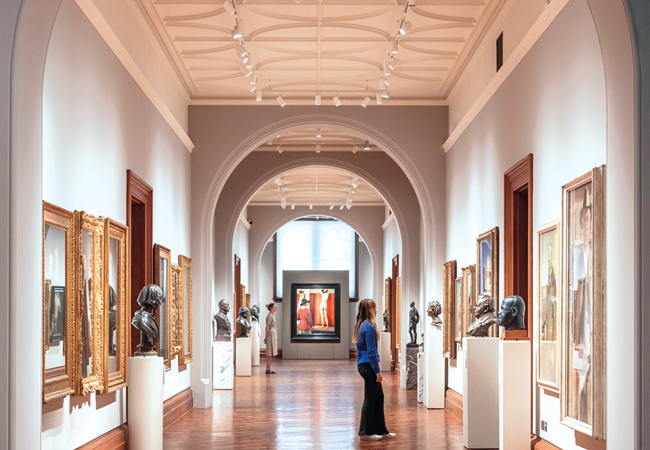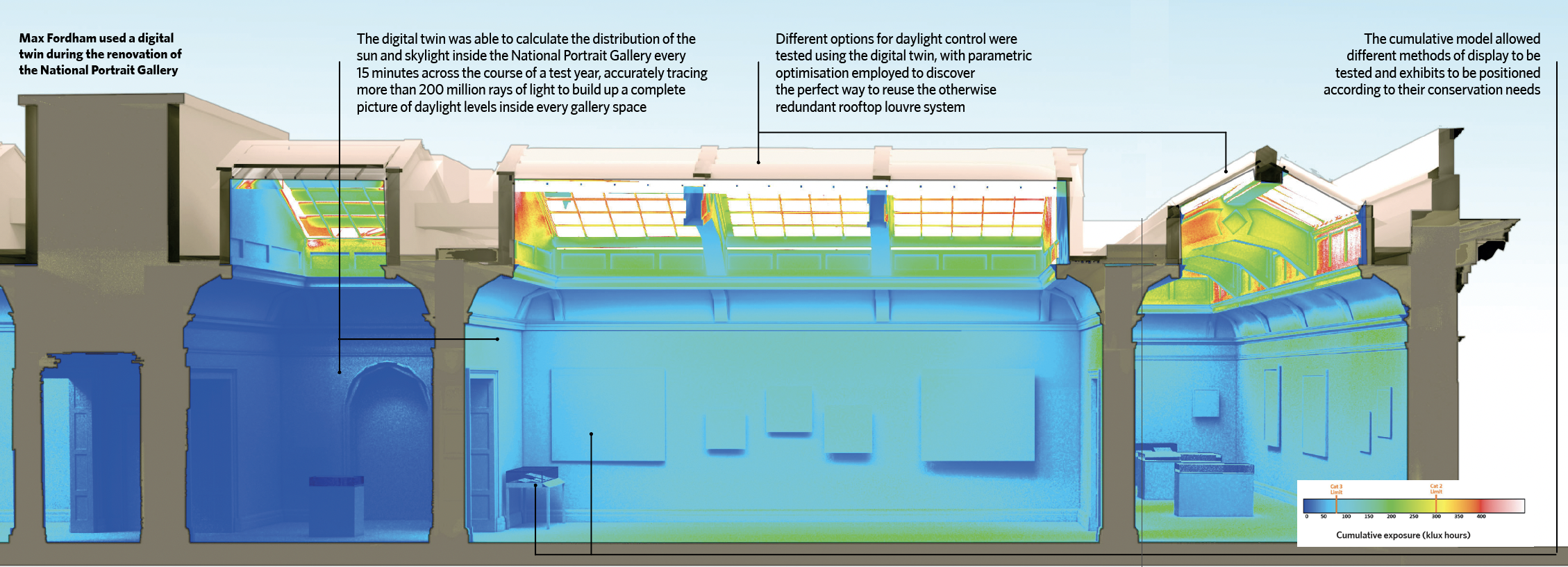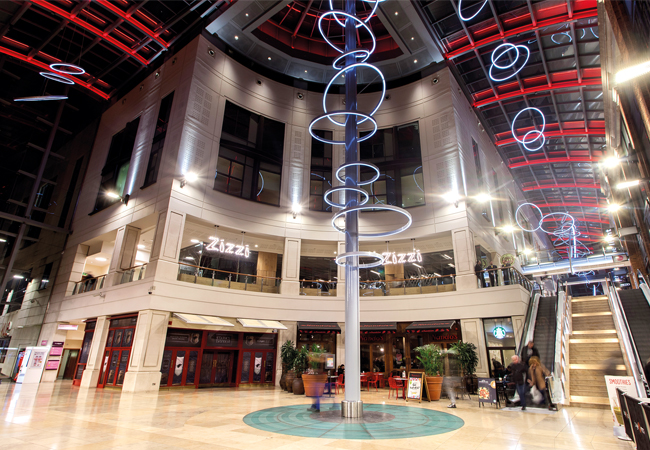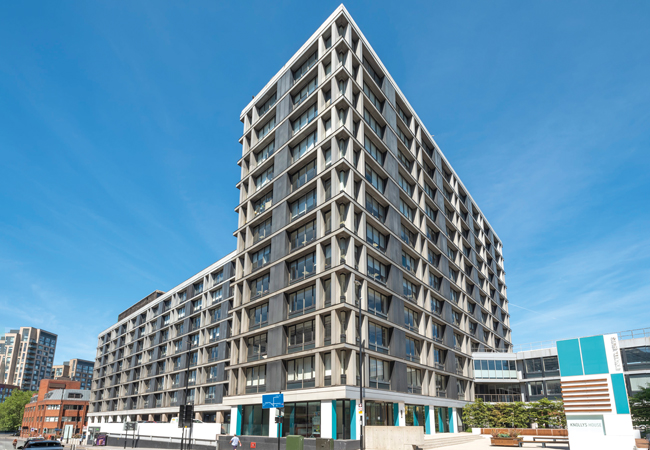
The National Portrait Gallery is now ‘reconnected with its surroundings’
There are many benefits to bringing daylight into museums and galleries – from improving the quality of lighting and saving energy and emissions, to providing a healthy environment that fights the ‘gallery fatigue’ visitors can otherwise face.
Though many of our museums and galleries were designed to be lit primarily, or even exclusively, with daylight, those openings have often been blocked up over the years because of concerns over conservation and light damage. The unintended effect of these measures has been to lessen the connection with the outside, making orientation more difficult and depriving occupants of the wider benefits of natural light.
Max Fordham is routinely tasked with safely reintroducing daylight into existing galleries and museums, as well as ensuring that we make the best use of natural light and views in our new-build projects. The challenge is to create beautifully day-lit spaces that maintain the standards of conservation needed for the utmost care of precious exhibits.
Our constantly changing climate means daylight levels are inconsistent and we need to aggregate them over a long period of time to understand them properly. The technology needed to undertake these kinds of virtual studies, as well as to validate them through long-term onsite monitoring, has only been developed recently, and is allowing us to use daylight much more extensively.
A good example of this is at the Hayward Gallery on London’s South Bank, where we were able to restore the iconic roof pyramids and return daylight to the galleries after an absence of 30 years.

Advanced analysis techniques now allow us to understand more precisely the distribution of natural and artificial lighting in every space, and we are able to give curators a much larger display area without increasing the size of the building. This, in turn, lessens our reliance on energy-intensive conditioning systems and allows us to greatly reduce the embodied carbon emissions of museum projects, through reuse and restoration, rather than demolition and rebuilding.
In the Queen’s Diamond Jubilee Galleries at Westminster Abbey, our detailed daylight modelling enabled the exhibits to be carefully placed around the path of incoming daylight. They filled previously unused spaces at balcony level and created a whole new gallery without the need for an extension.
Max Fordham built on this experience and created a digital twin of the National Portrait Gallery during its recent renovation, simulating the contributions of sunlight and skylight to the internal spaces over the course of a test year, using existing measured and future climate data. To achieve this, we generated 8,000 simulations, each requiring the accurate tracing of more than 200 million rays of light.
The design team then used the lighting model to plan exhibitions, design the artificial lighting, and test different approaches to window and rooflight treatments. The outcome has been a gallery reconnected with its surroundings, where visitors and staff can easily find their way about, and where the subtle changes in natural light over the course of each day offer a uniquely healthy and stimulating visual environment.
We also used the digital twin to repurpose the redundant system of rotating sun louvres – installed on the roof at the turn of the millennium – into new fixed shades. This eliminated the need to power them all day or to replace them as they fail. All the site team had to do was rotate each of the louvres to their perfect pitch to allow the natural light in the galleries to vary in close communion with the outside world, while the artworks remain safely within current conservation limits.
A well day-lit gallery needs a complementary system of artificial lighting, bringing flexibility, changes in mood, and the ability to focus light onto exhibits, as well as the facility to use the institutions outside daylight hours.
A well day-lit gallery needs complementary artificial lighting, bringing flexibility, mood changes, and the ability to focus light onto exhibits
The key trends in exhibition lighting at present follow those of the wider construction industry, with an increasing emphasis on human wellbeing, inclusivity and sustainability. In lighting terms, this means ensuring that the installation addresses the specific needs of different groups, such as: older people, who require more light to see clearly; those on the autism spectrum, who can be more sensitive to glare and for whom adaptable lighting with breakout spaces can offer respite; and people with dementia, who can be helped by designing away dark corners and sharp contrast within the galleries. Our aim is to achieve these goals using the minimum amount of energy and resources.
A thoughtfully designed artificial lighting installation can support the efforts of curators who are trying to create a more inclusive narrative in their museums and galleries. This means providing lighting for a much wider range of objects in a single space, often including those that may reveal a broader section of our history, but which are more sensitive to light – such as old photographs and letters.
The recently reopened National Portrait Gallery is a good example of this approach. Flexible, Bluetooth-controlled lighting structures enabled us to carefully position objects with different conservation needs in the same space, while still allowing views out and an overall feeling of brightness and clarity.
Advances in lighting controls and colour management mean we are able to design whole systems that can be adjusted for tone and colour temperature, allowing us to tune the lighting to each object so that they can be revealed to visitors in the best way possible.
At the Southbank Centre in London, all the lighting is digital multiplex (DMX) controlled and red, green, blue, white (RGBW) enabled, so each space can be put to many different uses, such as live music in the foyers and club nights in the café.
In summary, museums and galleries can benefit greatly from the judicious use of daylight, especially when coupled with a dynamic and flexible artificial lighting scheme. By combining advanced simulation techniques with the latest technologies in lighting and glazing, we can deliver cultural projects that are healthier, more engaging, more inclusive, and lower in both embodied and operational carbon.
About the author
Nick Cramp is a partner director of Light + Air at Max Fordham




